Schrade SCAXE10 Hatchet Reviewed
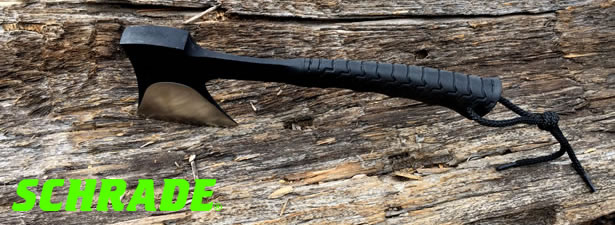
Marketing from Schrade
Schrade Full Tang Hatchet, Powder Coated 3Cr13 Stainless Steel Head with Hammer Pommel, Black TPR Rubber Wrapped Handle with Lanyard, Thermoplastic Belt Sheath
Manufacturer: Schrade, www.schrade.com
Model: SCAXE10
Overall Length: 11.08″ (28.14 cm)
Blade Steel: Powder Coated 3Cr13 Stainless Steel
Blade Length: 3.55″ (9.02 cm)
Handle Material: Full Tang Handle with Overmolded TPR Grip
Grip Length: 5.91″ (15.01 cm)
Weight: 1.37 lbs (23.4 oz)
Accessories: Thermoplastic Sheath
Warranty: Limited Lifetime Warranty against any manufacturing defects
UPC: 044356225502
MSRP: $35.20
The Review
I’ve been pretty happy with the quality and performance of Schrade’s SCAXE2 Survival Hatchet and SCAXE2L Survival Axe, each perfect for budget-strapped campers, preppers and survivalists who need a small hatchet or hand axe for processing wood. Then Schrade let me take their upcoming full-tang hatchet, the SCAXE10 for a spin…
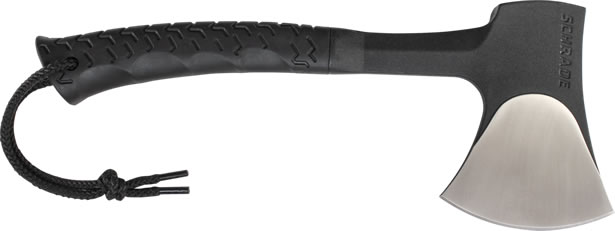
Initial Thoughts
I must admit that I love testing out bladed tools and weapons, and small hatchets are no exception. Out of the box, the edge of the SCAXE10 was definitely sharp enough to slice through a single sheet of paper with ease. So much so that I nicked myself pretty good just a few minutes after picking it up.
The SCAXE10 is a rugged one-piece packable hatchet made from a slab of 3Cr13 stainless steel with a large polished brushed-finish bevel, and a powder-coated head and handle for added protection from the elements. 3Cr13 is a terrific stainless steel alloy for an axehead because it is relatively easy to sharpen and holds an edge extremely well. However, stainless steel is only rust and corrosion resistant. Even with a protective coating, it is still susceptible to rust and corrosion without proper care and maintenance. If the hatchet becomes wet, simply dry it off and lightly coat it with a little oil before putting it away. If you take care of it, it just might last you a lifetime.
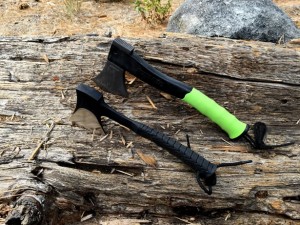 The most obvious difference between the SCAXE2 and SCAXE10 is the is the handle. Instead of the glass-reinforced handle found on the SCAXE2 and SCAXE2L, the SCAXE10 has a 9″ handle that extends from the axehead to the end of the overmolded TPR rubber grip. While the SCAXE10 really considered to be a full-tang hatchet, it is actually called a hidden-tang because you cannot actually see the tang protruding through end of the grip material.
The most obvious difference between the SCAXE2 and SCAXE10 is the is the handle. Instead of the glass-reinforced handle found on the SCAXE2 and SCAXE2L, the SCAXE10 has a 9″ handle that extends from the axehead to the end of the overmolded TPR rubber grip. While the SCAXE10 really considered to be a full-tang hatchet, it is actually called a hidden-tang because you cannot actually see the tang protruding through end of the grip material.
TPR is basically a Thermoplastic Elastomer similar to that of TPE, making it a perfect choice for a handle grip. The TPR surface provides a comfortable, non-slip surface, even in wet conditions. Additionally, the soft TPR material will absorb some of the vibration coming from the axe head as it strikes hard surfaces, thus reducing fatigue.
The grip itself is aggressively tapered from one end to the other with four finger grooves and a flared end that really improves the non-slip grip. The end nearest the axehead is very narrow so choking up on the hatchet feels a little awkward and uncomfortable without gloves. Probably just right for younger campers though. Personally, I would have preferred a little more girth along the entire 5.91″ grip which would have further improved on the comfort and control over the axehead.
For a secure grip, there is a lanyard hole about a half-inch up from the end of the handle with what looks like a short shoelace laced through it. Definitely something to swap out for paracord later.
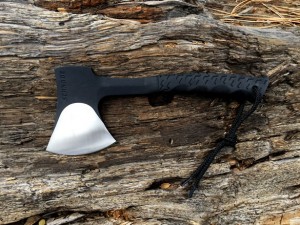 While the SCAXE10 has the exact same weight as the SCAXE2, it is only slightly smaller with an overall length of 11.08″. It is well-balanced and sized perfectly for single-handed operation so there is plenty of weight and leverage behind each swing, yet it is light enough to pack and wield without undue fatigue.
While the SCAXE10 has the exact same weight as the SCAXE2, it is only slightly smaller with an overall length of 11.08″. It is well-balanced and sized perfectly for single-handed operation so there is plenty of weight and leverage behind each swing, yet it is light enough to pack and wield without undue fatigue.
Being made from a solid hunk of steel, it is really very strong. No flex in the handle whatsoever. The butt-end (poll) of the hatchet is a semi-rounded hammer pommel that is 0.75″ wide and 1.9″ long without any machined knurling like the SCAXE2 had. Perfect for hammering on nails or tent stakes.
The SCAXE10 axehead comes protected by a thermoplastic belt sheath. A snap on the front secures the hatchet firmly in place. A quick tug on the snap allows for rapid deployment. A belt loop is molded onto the back of the sheath that is capable of supporting a belt up to 2″ wide. Additionally, there are five grommet holes providing numerous carry options. I expect that will be seeing aftermarket kydex sheaths available shortly after the SCAXE10 is released that will be far superior so watch for them.
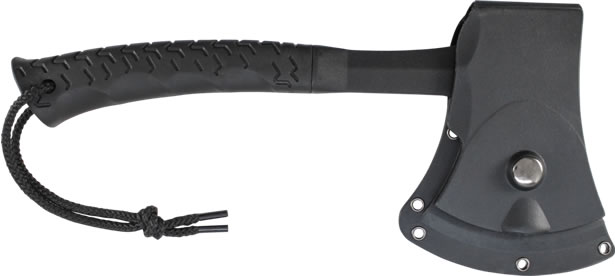
Functional Testing
Now lets see what Schrade’s SCAXE10 can really do… In order to provide a some semblance of an apples-to-apples comparison between axes and hatchets, I will be performing four durability and fine-control tests; Chopping, Log Splitting, Fine Blade Control and Edge Retention. In a survival situation, all resources are fair game. However, since I am not in a life-or-death situation, I’ll stick to some seasoned logs that I have lying around for these tests. I thoroughly recommend wearing eye protection and a good pair of gloves to protect your hands and absorb some of the vibration.
Chopping
For the first test, I thought that I would try my hand at delimbing some tree branches with the SCAXE10, then bucking a few pieces into a manageable size to be used in another test.
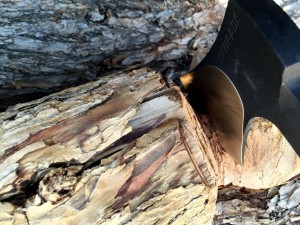 Delimbing the larger branches and stripping away the lighter foliage with the SCAXE10 was quick and easy. I was able to make quick work breaking down all of the smaller material around 1-2″ in size as well. Many with nothing more than a single swing.
Delimbing the larger branches and stripping away the lighter foliage with the SCAXE10 was quick and easy. I was able to make quick work breaking down all of the smaller material around 1-2″ in size as well. Many with nothing more than a single swing.
Next I tried bucking a 6″ branch into three pieces… When bucking material larger than a couple inches in diameter you simply strike the log at a 45° angle from two perpendicular directions along the cut-line, effectively making a “V” where the material used to be otherwise known as the kerf. The kerf should equal the diameter of the trunk, and when cutting from both sides, the kerf would essentially be half diameter.
At a little less than 12″ in length and total weight of 23.4 ounces, the SCAXE10 provides an ample amount of leverage and striking force. Though nothing like a full-size axe. However, with its highly-sharpened edge and aggressive blade angle, the SCAXE10 was able to bite deeply enough with each swing to make a difference. As a result, bucking the 6″ branch was possible to get through it with a fair amount of effort.
Log Splitting
After bucking the branch into three shorter pieces, the next task was to split them into kindling which brings us to the second functional test.
A word of caution when performing a task like this… It can be especially dangerous with a short axe or hatchet. Avoid any condition where the axe could break the vertical plane rule by swinging beyond its vertical plane without coming into contact with something other than your leg first. This task is best performed safely from the ground-level, and not high-up on a stump. Simply place the log on the ground that you are splitting, then kneel in front of it before you take a swing.
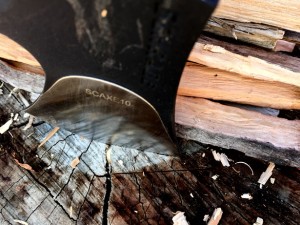 When I am using a small hatchet or hand axe, I typically like to have a baton handy to help persuade the axe through a log whenever it is needed. If the blade gets stuck, rather than struggling with it, just give it a little tap here and there and that is usually enough of an advantage to get the rest of the way through the log.
When I am using a small hatchet or hand axe, I typically like to have a baton handy to help persuade the axe through a log whenever it is needed. If the blade gets stuck, rather than struggling with it, just give it a little tap here and there and that is usually enough of an advantage to get the rest of the way through the log.
For this test, I stood the first of three logs up vertically on its end and swung the hatchet to halve it, then quarters, and so on until I had nothing more than a pile of small kindling left. Once the material was too small to stand up on its own, I moved in closer for the finer work. The logs were only about 12″ long so the splitting went pretty fast. Maybe about 5-minutes total.
The edge of the axe is so sharp that it easily penetrates the end grain and the polished bevel allows the head to glide through the material as it open it up. Rinse and repeat… Each of the other two logs took about 5 minutes each as well. The baton came in pretty handy more than a few times too. The extra leverage and control that it provides makes it so much easier to through the material.
I didn’t have any large material to split like I usually do. Though with the way this hatchet has been performing, I know it would have no trouble getting through it as long as you do it right. You simply cannot use the same method as you would splitting logs 6″ or smaller, even with a baton. The exercise would be futile. That is what wedges and splitting mauls are for.
To split larger material properly with a small hand axe or hatchet, you still strike the axehead against the top edge of the stump, just not perpendicular to the rings. Instead, you align the blade parallel to the rings. As a result, you are only removing small sections of the log, just an inch or two thick and maybe 3-4″ wide. Your baton will likely get a lot of use while you’re doing this. As you work your way around the log the diameter will continue to decrease, getting smaller and smaller until it is finally small enough to halve.
Fine Blade Control
The functional tests that always provide insight into how well a tool can perform fine bushcraft tasks are feathering sticks and making trap triggers. Each demonstrate fine blade control and its cutting edge.
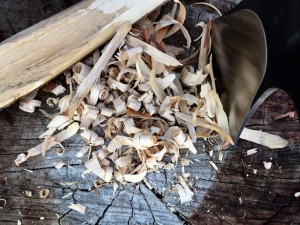 I started off the test with a piece of kindling about 2″ wide and 1″ thick. Then I began taking long strokes around the stick trying to keep the edge from digging in so I could shave long thin curls. The long polished blade bevel and extremely sharp edge of the SCAXE10 really excelled at this. It was easy to control the angle and the depth at which the blade bit into the material. My only complaint was with the thin handle… It was not very comfortable to choke all of the way up the handle without wearing gloves, but once you do, you have exceptional control over the blade.
I started off the test with a piece of kindling about 2″ wide and 1″ thick. Then I began taking long strokes around the stick trying to keep the edge from digging in so I could shave long thin curls. The long polished blade bevel and extremely sharp edge of the SCAXE10 really excelled at this. It was easy to control the angle and the depth at which the blade bit into the material. My only complaint was with the thin handle… It was not very comfortable to choke all of the way up the handle without wearing gloves, but once you do, you have exceptional control over the blade.
Next I tried my hand at making a really simple split-stick deadfall trap just to see if I could with the SCAXE10. I started off with a 1/2″ stick about 8″ long as my support stick. I shaved a small mark along one side of the stick and then I cut it in half. Then I notched the two halves where they fit together making a small 1/4″ hole down the center to hold the bait stick. Finally, I made the bait stick pointed at one end to hold the bait, and tapered at the other end so it fits snuggly into the notched hole between the two halves of the support stick.
While making a trap trigger with the SCAXE10 was not too difficult, it certainly was not as easy as it would have been with a bushcraft knife.
Edge Retention
After all of the functional testing had been completed, the SCAXE10 remained sharp enough to cleanly slicing through a single sheet of computer paper. The testing left no sign of cracks, chips or imperfections of any kind on the blade, and no sign of wear on the brushed finish at all. However, the black protective coating on the axehead did show some slight marring on the surface. The SCAXE10 held its edge exceptionally well, even with all of the punishment that I threw at it.
Final Thoughts
Schrade’s SCAXE10 is a rugged packable hatchet designed to get the job done, and built tough enough last, even under the most extreme survival conditions. Like its predecessor, the SCAXE10 is a rock-solid and versatile performer, perfect for outdoor enthusiasts and those with wilderness survival in mind. It is extremely compact, lightweight and well-balanced providing excellent control over the blade for intricate bushcraft tasks.
The SCAXE10 is comfortable to wield, especially with gloves. However, with a little more girth and a little less aggressive taper along the length of the grip, I think it would be much more comfortable for people with larger hands to wield. But don’t sell this little hatchet short. At $35, you really get a lot of bang for your buck with this hatchet. If you are prepping on a budget, the SCAXE10 is a very good option to consider. You can purchase a few of them for about half cost as one of the higher-end alternatives. Two thumbs way up on this one!
You can find this and other Schrade products here: http://amzn.to/2c0kjZF
![]()
About Taylor Brands and Schrade Cutlery
 Founded by Stewart Taylor in 1975, Taylor Brands has been manufacturing, designing, and distributing high-quality stainless steel cutting tools and accessories since our inception. Taylor Brands owns and produces Schrade, Old Timer, Uncle Henry, and Imperial branded products, and are also licensed to produce multiple product lines under the world famous Smith & Wesson brand. In total Taylor Brands manufactures several hundred different products including fixed and folding knives, collapsible batons, tactical pens, handcuffs, tactical and survival accessories, and flashlights.
Founded by Stewart Taylor in 1975, Taylor Brands has been manufacturing, designing, and distributing high-quality stainless steel cutting tools and accessories since our inception. Taylor Brands owns and produces Schrade, Old Timer, Uncle Henry, and Imperial branded products, and are also licensed to produce multiple product lines under the world famous Smith & Wesson brand. In total Taylor Brands manufactures several hundred different products including fixed and folding knives, collapsible batons, tactical pens, handcuffs, tactical and survival accessories, and flashlights.
--